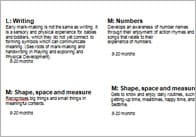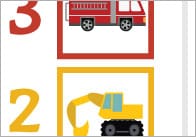Dyslexia Teaching Resources

This week is Dyslexia Awareness Week and so we decided to create a few resources aimed at helping people who confuse certain letters and numbers. They were designed by our new illustrator / graphic designer Kristina Heinesen.
We’ve put them together in our new dyslexia resources section. We intend to add to this section over time, so if you have any ideas for resources to help people who experience difficulty reading, writing or spelling then please get in touch, we’d love to hear from you.
Dyslexia Awareness Week 2012
The theme of Dyslexia Awareness Week 2012 is ‘Empowering Teachers’. It is thought that some 10% of the population suffer with dyslexia to some degree. Despite this alarming statistic there is no formal requirement for teachers to receive any sort of training to help them identify and support pupils with dyslexia. The British Dyslexia Association have started a petition asking for dyslexia training to be incorporated in to Initial Teacher Training. Specifically they want teachers to be made aware of when to refer pupils for assessment and to be trained to understand dyslexia, its impact on learning and what constitutes dyslexia friendly practice.
Some background to Dyslexia
Dyslexia is known as a ‘specific learning difficulty’ in the sense that its affect is limited to certain skills and abilities. It is not a sign of low intelligence. In fact it’s quite the opposite. Statistics show that those who suffer from Dyslexia tend to have a higher than average IQ. Some of the world’s most eminent scientists, inventors and artists had traits associated with dyslexia. These include Leonardo da Vinci, Pablo Picasso, Andy Warhol Albert Einstein, Thomas Edison, Alexander Graham Bell, Michael Faraday…the list is endless. So it really has no relationship to a person’s general level of intelligence. It is simply a problem in the way that the brain process information causing messages not to be accurately transmitted.
There are varying degrees of dyslexia. Those who are on the spectrum tend to have problems with some or all of the following: reading, writing, spelling, language and communication skills, mathematics, short term memory, distinguishing left from right, organisation skills and understanding sequences / patterns. Dyslexia will often exist in parallel with other related disorders including dyspraxia, attention deficit disorder and autism.
Getting help
If undiagnosed or unsupported dyslexia can lead to deep rooted emotional and social difficulties including low self-esteem, anger, frustration and behavioural problems. Early detection is therefore crucial. Although teachers are not required to have specific dyslexia training they should still be your first port of call if you are concerned that your child is suffering from the condition. If they share your concern then they will involve the special educational needs co-ordinator who will offer more support. The school should also arrange for an assessment by an educational psychologist.
If a child is formally diagnosed with dyslexia they have a statutory right to receive additional support in the classroom. Upon application to the local education authority parents should receive a statement of special educational needs which lists the child’s specific needs and how they should be fulfilled in school. If you believe that the dyslexia is having an extremely negative impact on your child’s personal, social and emotional wellbeing then you should probably seek specialist help from Child and Adolescent Mental Health Services. You will need to discuss this with your local GP. An alternative would be to seek help from youth counselling services.
Popular Teaching Resources
Stay Up To Date
Sign up for our newsletter and we’ll let you know when we create new early years resources.





